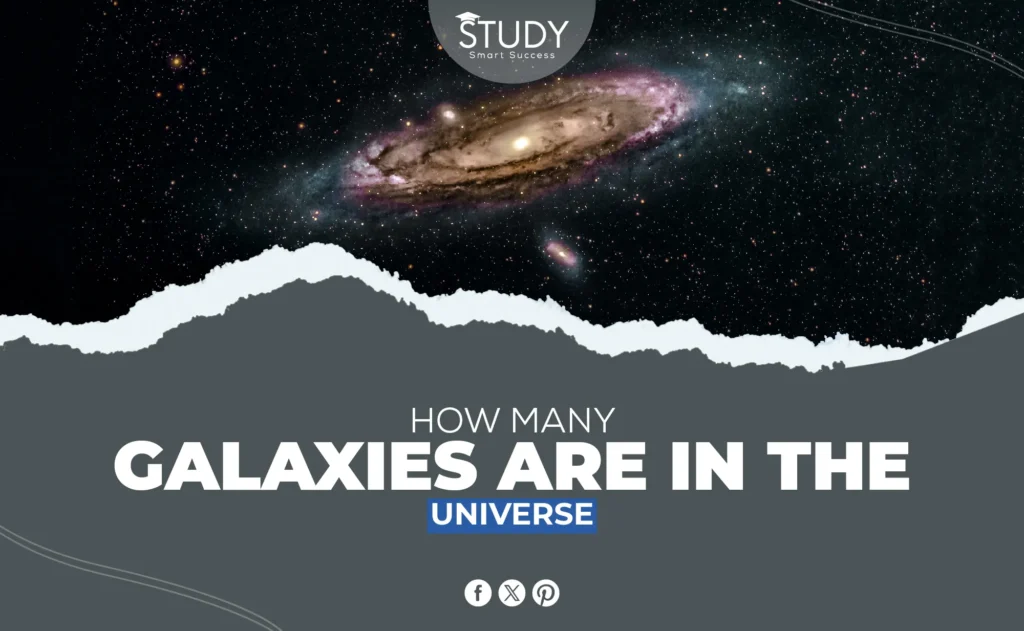Introduction
Gravity holds stars, dust, gas, and dark matter in galaxies. The universe is built from dwarf galaxies with 100 million stars and giants with 100 trillion stars. Numerous star systems and nebulae shape the universe’s structure and evolution. One might ask, How many galaxies are there? As many as two trillion contribute to the universe’s beautiful fabric.
Scientists are fascinated by the universe’s immensity and quantity of galaxies. The Milky Way was once the cosmos to astronomers. In the 1920s, Edwin Hubble discovered the Milky Way is one of countless galaxies. This discovery enlarged our cosmos from one galaxy to billions with star systems and celestial events. Space exploration and size understanding are improving with technology.
What are Galaxies?
Galaxies are formed by gravitational forces between stars, stellar remnants, gas and dust, and dark matter. Galaxies vary tremendously in size. They can be a few thousand to hundreds of thousands of light-years across, with millions to trillions of stars orbiting a core. Galaxy masses are billions to trillions of times the Sun’s. Structured and amorphous galaxies exist.
Types of Galaxies
Based on their forms and properties, galaxies are classified into various categories, each with distinct formation and evolution insights:
- Spiral Galaxies: Featuring revolving flat disks with curved arms that extend from a center bulge. They are brighter than the galaxy because young, blazing stars form in these arms. We live in a spiral galaxy, the Milky Way.
- Elliptical Galaxies: Ellipsoidal galaxies are approximately spherical to elongated ovals and less complex than spiral galaxies. They have cooler, older stars with less interstellar matter and star formation. These galaxies are heavier than spirals.
- Irregular Galaxies: These are chaotic and lack a bulge or disk, hence their name. Star-forming zones are common in irregular galaxies with gas and dust. Gravitational interactions or collisions with other galaxies may have shaped these galaxies.
Astronomers must understand galaxies’ diversity and features to determine their number and the universe’s vastness and complexity. Each type shows the range of celestial formations and reveals cosmic history, from galaxy formation to gravitational interactions.
The Expanding Universe
Modern cosmology and astronomy are based on the idea that the world is growing. Many data from observations backs it up, especially the redshift of galaxies far away. Light stretches and moves toward the red end of the spectrum, causing this effect. This means that these galaxies are moving away from us.
- Cosmic Microwave Background (CMB): In Big Bang physics, this is the thermal radiation left over from the time of recombination. It shows what the universe looked like when it was first formed. The uniformity and spread of the CMB back the idea that it is expanding.
- Hubble’s Law: This law was made by Edwin Hubble and says that the speed at which a galaxy moves away from us is equal to its distance. This finding was very important in proving that the universe is getting bigger.
How This Affects Our Understanding of the Number of Galaxies
The universe’s growth has a direct effect on how we think about how many galaxies it has in several important ways:
- Increasing Volume: As the universe expands, the visible volume grows, which means there are probably more galaxies inside this volume.
- Observable Universe: Counting galaxies is limited by the universe’s size. As the universe grows, more zones appear. Since expansion exceeds light speed, light from remote parts may never reach us.
- Evolution of Galaxies: Expansion changes how galaxies form and change over time. The number of galaxies can change as they join, grow, or disappear.
Understanding the universe’s expansion improves astronomers’ galaxy counts. It also shows how the cosmos constantly changes, bringing new galaxies into view and pushing others out. This expansion challenges and improves our estimates of the number of galaxies, giving us a moving target to understand the universe’s immense complexity.
Estimations and Discoveries
The first astronomers used telescopes constrained by their technology to quantify the universe. Astronomers initially only detected the brightest galaxies, severely underestimating the actual number. Scientists estimated there were thousands to millions of galaxies before the mid-20th century. However, we discovered more galaxies than expected when telescope technology improved, notably by deploying more powerful orbital observatories.
The Role of the Hubble Space Telescope in Revising These Numbers
Our ability to study the universe improved with the 1990 launch of the Hubble Space Telescope. Hubble’s high resolution and position outside Earth’s atmosphere allow it to see farther into space than ever, providing a more complete view of the universe. Astronomers have investigated billion-light-year-distant galaxies at different stages using Hubble Deep Field and Ultra Deep Field images.
The number of galaxies was substantially changed by these measurements. The universe may have two trillion galaxies, many of which are too faint and distant to see with current equipment. Hubble’s discoveries have allowed us to see light from post-Big Bang galaxies. Our cosmic catalog’s ongoing updating influences cosmology, including universe structure and fate hypotheses.
Challenges in Counting Galaxies
Factors That Complicate Galaxy Detection
There are a lot of astronomical factors that make it hard to figure out the exact amount of galaxies in the universe:
- Distance: A galaxy’s distance makes it harder to detect. Some galaxies are so distant that their light hasn’t reached Earth yet, taking billions of years.
- Brightness: There are a lot of galaxies that are too weak for our telescopes to see. Even with the most modern technology, it can be hard to capture and study the dim light that faraway galaxies give off.
- Dust: Galaxy views can be blocked by cosmic dust. It’s hard to see the galaxies behind this dust because it absorbs and spreads light.
Technological Limitations
Even though modern astronomy technology has a lot of great features, some big problems make it hard to count galaxies:
- Resolution and Sensitivity: The sharpness and sensitivity of today’s telescopes are limited, which makes it harder for them to find faint and faraway galaxies.
- Field of View: A narrow field of view means that many powerful binoculars can only see a small part of the sky at a time. This makes thorough polls hard to understand and takes a lot of time.
Astronomy technology and methods may disclose more about the universe’s structure, increasing the number of galaxies and enhancing our comprehension of cosmic processes. Each technological advancement illuminates more galaxies and sharpens our vision of the universe’s rich tapestry.
Implications of Galaxy Count
The universe’s estimated number of galaxies is vital to our understanding of its composition and evolution:
- Composition: There are more galaxies, which means there are more kinds, sizes, and formations of galaxies in the universe. Astronomers use this variety to determine how matter and energy were spread at different times.
- History: When scientists look at the light from galaxies that are far away, they can see how they have changed over billions of years. We can use this “cosmic timeline” to see how the world has grown and changed.
How This Knowledge Impacts Theories of Cosmology
We can learn about the structure of the universe from the number of galaxies, and it also affects basic ideas in cosmology:
- Big Bang Theory: More galaxies and their speed and composition confirm the Big Bang theory, revealing the universe’s expansion and cooling.
- Dark Matter and Dark Energy: The mass and gravitational effects of galaxy movements suggest dark matter and dark energy shape the cosmos.
- Formation and Growth of Galaxies: The number of galaxies, ages, and distances help enhance theories of galaxy formation, black hole formation, star formation, and intergalactic interactions.
The galaxy count and its consequences go beyond numbers; they explain the universe’s underlying laws. We get deeper insights and more accurate predictions about the universe’s fate as we count galaxies and update our cosmos models. This constant interaction between observation and theory advances science and deepens our understanding of the universe.
Conclusion
We’ve investigated the complexity of counting galaxies, revealing the breadth of our cosmos and the difficulties of quantifying it. From defining a galaxy and addressing its types to acknowledging the universe’s expansion’s effect on our ability to detect them, this trip has deepened our comprehension.
Technological advances like the Hubble Space Telescope have helped boost the estimated number of galaxies from hundreds to perhaps two trillion. These discoveries enhance our grasp of the universe’s vastness and refine the Big Bang, dark matter, and energy ideas.
Our hunt for knowledge is as vast as the universe and our role in it. Each discovery illuminates the universe’s immense tapestry, furthering our understanding and rekindling our curiosity. As we progress technology and explore the unknown, we will better understand the universe and ourselves. This ongoing adventure reflects our cosmic curiosity and thirst for knowledge.


